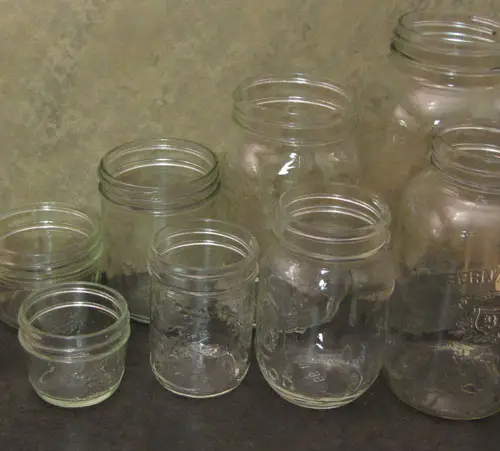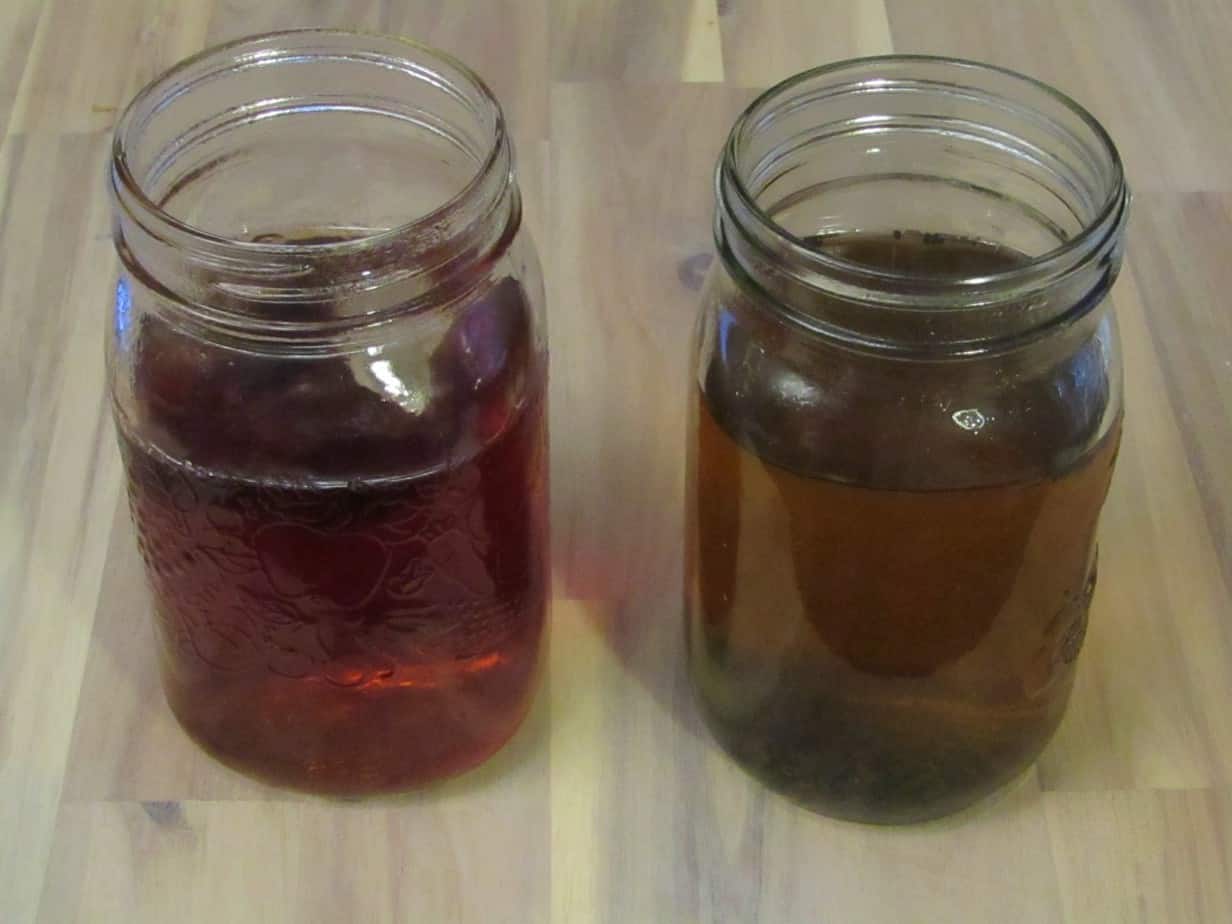This post contains affiliate links.
Mason jars are everywhere. They can be found in thrift stores, hardware stores, grocery stores and online. With their prevalence they have been used for a variety of things which they were not meant to be used for, such as fermentation.
Mason jars are ideal for making small batches of kombucha. The thick glass sides make them robust and non-reactive to its contents, are easily cleaned and come in a variety of sizes. They do not perform well for second fermentation as the seals are not designed to hold pressure.
Kombucha can be made in a variety of containers like plastic food grade containers, ceramic fermentation crocks and stainless steel fermentation vessels but the best choice is a glass container designed to preserve food. Enter the mason jar.
How to use mason jars for kombucha
Mason jars are prevalent today, they can be found everywhere from the grocery store to thrift stores. The most common sizes are the quart jar and the liter jar but they also come in two liter and gallon sizes.
Use as your primary fermentation vessel
Mason jars are perfect for using as your primary fermentation vessel if you are only making kombucha for yourself. The larger half gallon and gallon sizes are harder to find but once you have them will last a long time if they are taken care of.
They come with graduated markings on their sides to help in measuring out the ingredients and are designed to hold hot liquids unlike most drink dispenser glass containers which may have thin glass on the sides which can break easily.
Test new kombucha recipes
The smaller sizes are great for testing new recipes as the small amount of kombucha needed to start one of these jars is small and you will only need a little SCOBY to introduce enough gluconobacter bacteria to promote SCOBY growth. This makes it a low risk venture to try different types of tea, steeping times, types of sugar and fermentation times.
Transport kombucha starter
Quart sized jars make great containers to pack and transport a kombucha starter. You can easily put a SCOBY and some starter kombucha in one of these jars and take it with you on longer trips when you don’t want to be without it or for passing a starter on to someone else.
Age some kombucha to vinegar
Once you have been making kombucha for a while you will experience a time when a batch gets left a little too long or the temperature was a little hotter than normal and the batch became too sour to drink enjoyably. All is not lost! Pour the sour kombucha into mason jars, add a little more sugar and age it to vinegar.
Kombucha is a fermentation which includes all three of the most prevalent fermentation microorganisms: Acetic acid bacteria, lactic acid bacteria and yeast species. This makes for a very interesting full bodied vinegar which can be used for a variety of purposes like salad dressings, marinades and sauces.
Since the amount of sugar used to make drinkable kombucha is insufficient to produce enough acid for a good vinegar you should add more sugar for the culture to convert into acetic and lactic acid.
Choose the right size of mason jar for your needs

Mason jars come in tiny 4 oz jelly jars all the way up to one gallon containers. To determine the ideal size you will have to do some math.
- Determine how many bottles of kombucha you currently consume on a daily basis
- Multiply the volume of bottle by seven
- If you second ferment your kombucha, subtract the amount of volume you add for your flavoring method.
- Add in the volume you need from reserved kombucha starter (about 10%)
- Add in a little for the SCOBY volume
You now have the minimum sized jar you will need to make a weekly amount of kombucha.
The most common are the quart size jars which are a little small for most avid kombucha drinkers. The four quart or liter jars provide enough kombucha for most people’s weekly kombucha habit..
Cleaning mason jars for kombucha fermentation
The kombucha fermentation container needs to be clean before you start your first batch of kombucha. Wash it by hand with soap and hot water. Scrub any food residue from the inside and outside of the jar. If there is any hard water buildup remove them by soaking in white vinegar. Rinse thoroughly to remove any soap residue and let air dry.
If the jar is new you can run it through the dishwasher to remove any manufacturing residue.
Do not worry about sanitation as it is not realistic to achieve in the home kitchen and the kombucha culture if taken care of properly is strong enough to resist any pathogenic or spoilage microorganisms if your kitchen is clean.
Benefits of mason jars for kombucha fermentation
Designed for repetitive use
We are inundated with one time use of manufactured products and packaging. We purchase coffee, bottled water and grocery items in containers which are pitched after one time use. Even glass bottles which most kombucha is sold in are not recycled but crushed to form a covering for landfills to keep the light waste particles down.
Mason jars on the other hand are designed for reuse. They are strong enough to withstand abuse, do not break down in the sun and do not leach chemicals into the food we store in them.
Can hold hot liquids
Glass containers which are not meant to hold hot liquids are prone to cracking when hot liquids are put in them . This is because their sides are not uniform and or have thin glass in places. This makes them susceptible to cracking when heated quickly (like when hot liquids are poured into them).
Mason jars are designed for this exact purpose so you can make the tea for your kombucha in the same jar as you are going to use to ferment it. Simply boil the water, pour it over the tea bags or through a tea strainer and steep it as long as you like. Once the tea is strong enough remove the tea bags or strainer add sugar and let cool before adding the SCOBY and reserved kombucha.
Are easy to clean
Mason jars come in two mouth sizes: large and small but both sizes are large enough to easily access the inside of the jar to clean. The glass is smooth and does not absorb its contents even if it has been left for years.
For easy cleaning they can be placed in the dishwasher or washed in the sink with mild soap and water. For deep cleaning where food particles are stuck to the sides they can be soaked in hot water and soap or washed with an abrasive scrubby without worry of scratching the surface.
Do not use metal scouring pads as they can leave scratches instead use a bamboo handled bristle brush (biodegradable)
Drawbacks of using mason jars for making kombucha soda
Although mason jars are great for the primary fermentation of kombucha the secondary fermentation process has some inherent characteristics which make mason jars a poor choice.
Mason jars are not designed to hold pressure and will produce flat kombucha soda at best or at worst may explode, which can be dangerous and messy. The acidic nature of the liquid can rust the lids and rings, tainting the flavor of the kombucha making it undrinkable.
Mason jars are not designed to hold pressure
Mason jars are great primary fermentation vessels but make poor secondary containers as they are not meant for holding pressure.
The standard sealer lid is designed to hold pressurized air out of the jar not in the jar. The rings which hold them on are only necessary for a short while while the contents of the jar cool down. Once the air in the jar has cooled and the pressure dropped the vacuum produced keeps the jar sealed.
Second fermentation of kombucha produces carbon dioxide which pressurizes the jar from the inside. Two things can happen in this situation:
The jar could burst
If the ring on the jar is tight enough it can actually seal the pressure into the jar but mason jars are not meant to hold pressure. This can cause explosive results which can be dangerous and messy.
The gas could escape
This is the more likely event. The carbon dioxide gas which carbonates the kombucha will escape leaving your kombucha only lightly carbonated. This is disappointing as most people like the carbonation level to be similar to that of soda pop.
If you are going to make kombucha soda get some swing top bottles which are made to hold pressure. They can be purchased at beer making stores online at Amazon. Be careful to get bottles meant for fermentation as there are swing top bottles which are decorative or designed to hold hot sauce or other non-carbonated liquids.
Another option is to save swing top bottles from other carbonated beverages. They are getting more and more available.
The sealers may rust
The sealers on mason jars are thin metal with a thinner plastic coating on them. They are meant to be thrown away after one use. The volatile components of the kombucha can evaporate into the headspace of the jar and through the seal. The edge of the sealer tends to start to oxidize (rust) as the acidic volatile components are released into the air.
Not only does this destroy the sealer but it also can contaminate the kombucha giving it a metal flavor which is not really pleasant.

